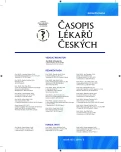Centres for Tobacco-Dependent in the Czech Republic in 2012: overview and economy
Authors:
Eva Králíková 1,2; Alexandra Kmeťová 1,2; Vladislava Felbrová 1; Stanislava Kulovaná 1; Jiří Rameš 2; Lenka Štěpánková 1,2; Kamila Zvolská 1,2; Jana Skoupá 3
Authors‘ workplace:
1. LF UK, Praha
; Centrum pro závislé na tabáku III. interní kliniky 1. LF UK a VFN, Praha
1; Ústav hygieny a epidemiologie 1. LF UK a VFN, Praha
2; Medicínské datové centrum
3
Published in:
Čas. Lék. čes. 2014; 153: 246-250
Category:
Original Article
Overview
Backround.
Since 2005, in the Czech Republic the Centres for Tobacco-Dependent are being established at hospitals.
Methods.
Evaluation of the activity of these 37 centres in 2012, economic analysis of treatment costs and assessment of the cost of life year gained (LYG).
Results.
Most of the centres (26 of 37) are based at pulmonary clinics with opening hours for smokers: on average 7 hours/week. Treatment codes 25501 and 25503 are used at 28 centres. Entry visit usually takes on average 61 minutes, follow-up visits 22 minutes. Nicotine replacement therapy and varenicline are indicated in all centres, but only 14 centres use bupropion. Virtually all centres use links to other clinical disciplines, about 10.5 % of patients are sent to other departments. The most common barriers for wider activity are insufficient salaries and staffing. In 2012, the Centre for Tobacco-Dependent at the 3rd Medical Department, 1st Faculty of Medicine, Charles University in Prague and the General University Hospital treated 430 patients for the price of 3792 CZK per treated patient (≈ 150 Euro), respectively, with 38 % success rate for the price of 10,003 CZK per abstinent patient (≈ 400 Euro), or for 1,334 CZK per LYG (≈ 50 Euro/LYG).
Conclusion.
In the future it would be good to improve working conditions in centres and to take advantage of their potential for the indispensable, effective and highly cost-effective treatment.
Keywords:
Centres for tobacco-dependent – treatment – personnel – economics – cost-effectiveness – Life Year Gained (LYG)
Sources
1. Croghan IT, Offord KP, Evans RW, Schmidt S, Gomez-Dahl LC, Schroeder DR, Patten CA, Hurt RD. Cost-effectiveness of treating nicotine dependence: the Mayo Clinic experience. Mayo Clin Proc 1997; 72(10): 917–924.
2. Hurt RD, Ebbert JO, Hays JT, McFadden DD. Treating tobacco dependence in a medical setting, CA Cancer J Clin 2009; 59(5): 314–326.
3. Kralikova E, Kmetova A, Stepankova L, Zvolska K, Davis R, West R. Fifty-two-week continuous abstinence rates of smokers being treated with varenicline versus nicotine replacement therapy. Addiction 2013; 108(8): 1497–1502.
4. Doll R, Peto R, Boreham J, Sutherland I. Mortality in relation to smoking: 50 years’ observations on male British doctors. BMJ 2004; 328 : 1519.
5. Stapleton JA, West R. A direct method and ICER tables for the estimation of the cost-effectiveness of smoking cessation interventions in general populations: application to a new cytisine trial and other examples. Nicotine Tob Res 2012; 14(4): 463–471.
6. The NICE Tobacco Return on Investment Tool, National Institute for Health and Clinical Care Excellence, www.nice.org.uk/usingguidance/implementationtools/returnoninvesment/TobaccoROITool.jsp
7. Flack S, et al. Cost-effectiveness of Interventions for Smoking Cessations. York Health Economics Consortium 2007; www.nice.org.uk
8. Wang D, et al. ‘Cut down to quit’ with nicotine replacement therapies in smoking cessation: a systematic review of effectiveness and economic analysis. Health Technology Assessment 2008; 12(2): III–IV, IX–XI, 1–135.
9. Annemans L, et al. Cost effectiveness of varenicline in Belgium, compared with bupropion, nicotine replacement therapy, brief counselling and unaided smoking cessation: a BENESCO Markov cost-effectiveness analysis. Clin Drug Investig 2009; 29 : 655–665.
10. Doležal T. Kde leží hranice ochoty platit za QALY? Farmakoekonomika 2007; 2(1): 21–22.
11. Nohler E, et al. Long-term follow-up of a high - and a low-intensity smoking cessation intervention in a dental setting – a randomized trial. BMC Public Health 2013; 13 : 592–601.
12. Jorenby DE, et al. Efficacy of varenicline, an _4_2 nicotinic acetylcholine receptor partial agonist, vs placebo or sustained-release bupropion for smoking cessation. a randomized controlled trial. JAMA 2006; 296(11): 56–63.
13. Nides M, et al. Smoking cessation with varenicline, a selective α4β2 nicotinic receptor partial agonist. results from a 7-week, randomized, placebo - and bupropion-controlled trial with 1-year follow-up. Arch Intern Med 2006; 166 : 1561–1568.
14. Gonzales D, et al. Varenicline, an α4β2 nicotinic acetylcholine receptor partial agonist, vs sustained-release bupropion and placebo for smoking cessation. A Randomized Controlled Trial. JAMA 2006; 296(1): 47–55.
15. Tonstad S, et al. Effect of maintenance therapy with varenicline on smoking cessation. a randomized controlled trial. JAMA. 2006; 296 : 64–71.
16. Aubin H-J, et al. Varenicline versus transdermal nicotine patch for smoking cessation: results from a randomised openlabel trial. Thorax 2008; 63 : 717–724.
Labels
Addictology Allergology and clinical immunology Angiology Audiology Clinical biochemistry Dermatology & STDs Paediatric gastroenterology Paediatric surgery Paediatric cardiology Paediatric neurology Paediatric ENT Paediatric psychiatry Paediatric rheumatology Diabetology Pharmacy Vascular surgery Pain management Dental HygienistArticle was published in
Journal of Czech Physicians

Most read in this issue
- Perioperative chemotherapy in gastric cancer treatment – the surgeon’s view
- Mutagenic effect of advanced paternal age in neurocardiofaciocutaneous syndrome
- Calcium, dairy products and weight reduction
- Basic biological roles of galectins in tissue repair and tumor growth
